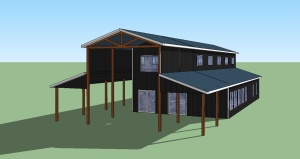The phones ring at Hansen Pole Buildings every day from dawn-to-dusk, and sometimes both before and after. Some calls are a little more interesting than others.
Bright and early, first thing this morning Eric (one of the owners of Hansen Pole Buildings) gets a phone call from Lowe’s®.
 It seems Lowe’s® has a pole building contractor customer who really likes to use composite skirt boards. As Lowe’s® did not have a source, they started doing some research. It turns out the caller from Lowe’s® had read my article about them online (which prompted the call): https://www.hansenpolebuildings.com/blog/2013/08/composite-grade-board/
It seems Lowe’s® has a pole building contractor customer who really likes to use composite skirt boards. As Lowe’s® did not have a source, they started doing some research. It turns out the caller from Lowe’s® had read my article about them online (which prompted the call): https://www.hansenpolebuildings.com/blog/2013/08/composite-grade-board/
Eric and the gentleman from Lowe’s® had some friendly discussions about not only the composite skirt boards, but also in regards to the company which typically promotes and sells them. It seems the two of them were pretty much in agreement in their negative opinion using composite material for skirt boards.
The fun part of the conversation came later…after it was related to Eric how the builder (after sharing his love of composite skirt boards) proceeded to explain how he ran his interior liner steel to grade then filled it 4″ high with concrete on the steel ! Not only was the builder doing this, but he was proud of it!
For those readers who are unfamiliar with steel liner panels, they are most often used in the Midwest. The panels are typically the same profile as the steel roofing and siding. They are oftentimes very thin (sometimes even 30 gauge material) and feature low cost typically white polyester paint over a minimal galvanized or Galvalume® substrate.
Here is where things could get dicey for this particular builder. Pre-painted Galvalume® sheets are not to come in contact with wet concrete. Concrete’s high alkalinity attacks aluminum in Galvalume, causing coating to peel. How would the builder know what the substrate was? He’d have to be asking who he purchased it from, and unless it was directly from the manufacturer, there is a good chance he won’t get the correct answer.
I am not a huge proponent of steel liner panels to begin with, but if I did have them in my building, I’d prefer the paint stayed on them!
Scratching my head, I am still trying to figure out why the builder is pouring against the liner….and can come up with only two things. The first is – it would save some concrete (between the liner panel and the skirt board). About a yard on an average 40’ x 60’ building. Of course the concrete savings would be offset, to a large part, by the extra four inches of steel liner panel around the entire perimeter.
The second reason….(and this is merely a guess) is the composite skirt boards may be too flexible to reliably pour against without bowing outward, or requiring a tremendous number of stakes to hold them in place.
Any ideas from the audience? My wife, in a previous marriage, was married to a hog farmer – and she relates one of their buildings was done exactly like this – and why it was done that way. As happens in our “almost perfect” marriage, we don’t always agree – which is why I married her – we can “agree to disagree”. Anyone else besides my lovely bride of 14 years have good reasons to run concrete over the bottom edge of horizontal interior steel panels? Let me know!







The reason he did this I’ll bet is to avoid pulling off the job between the shell of the building being erected and the interior package being installed. I feel the best way to do it is build the shell, pour the concrete, then do the liner.
I would agree with the recommendation to pour the concrete slab prior to liner installation.